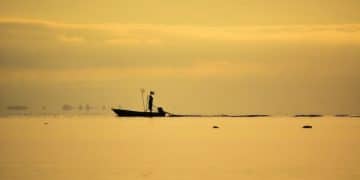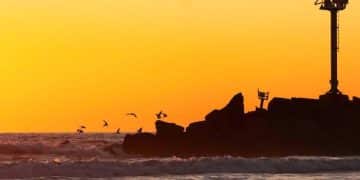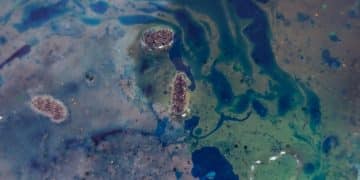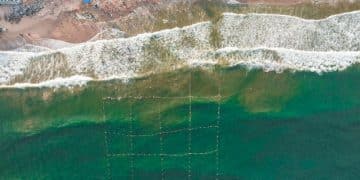Emerging Threats to US Marine Biodiversity: Solutions
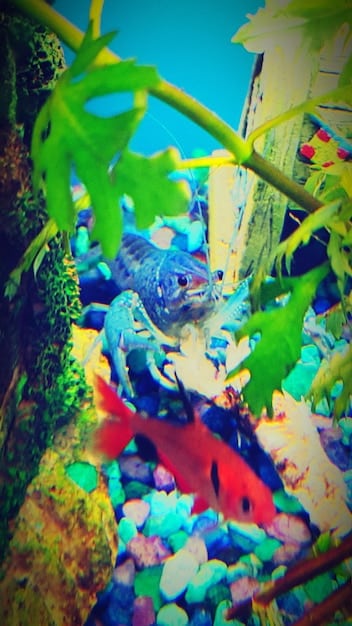
Addressing the complex and evolving threats to marine biodiversity in US waters necessitates a multifaceted approach, integrating rigorous scientific research, adaptable policy frameworks, robust enforcement, and collaborative community engagement to ensure the long-term health and resilience of critical marine ecosystems.
The vast and diverse marine ecosystems within US waters are facing an unprecedented array of challenges. Understanding What are the Emerging Threats to Marine Biodiversity in US Waters, and How Can They Be Addressed? is crucial for effective conservation. Protecting these invaluable resources requires not just an awareness of the dangers, but also a proactive and collaborative societal response.
Rising Ocean Temperatures and Acidification
The pervasive impact of climate change on marine environments is undeniable, manifesting primarily through rising ocean temperatures and increased ocean acidification. These twin threats fundamentally alter marine habitats and physiological processes of countless species.
Elevated water temperatures stress marine organisms, leading to coral bleaching, species migration to cooler waters, and a disruption of delicate food webs. Many species have narrow thermal tolerances, and sustained warming pushes them beyond their physiological limits.
Impact on Coral Reefs and Shellfish
Coral reefs, often called the “rainforests of the sea,” are particularly vulnerable. When water temperatures exceed their acceptable range, corals expel the symbiotic algae living in their tissues, turning white in a process known as bleaching. While corals can recover from mild bleaching, severe or prolonged events can lead to widespread coral mortality, devastating entire reef ecosystems.
- Coral bleaching events are becoming more frequent and severe in US waters, including Florida and the Pacific Islands.
- Loss of coral reefs diminishes habitat for thousands of marine species.
Ocean acidification, caused by the absorption of excess carbon dioxide from the atmosphere into seawater, reduces the pH of the ocean. This makes it more difficult for marine organisms, especially those with calcium carbonate shells or skeletons, to build and maintain their structures. This includes vital species like oysters, crabs, and pteropods (sea snails that form a crucial part of the food web).
Addressing these threats requires a global commitment to reducing greenhouse gas emissions. Domestically, this means transitioning to renewable energy, improving energy efficiency, and investing in carbon capture technologies. Locally, fostering the resilience of ecosystems through marine protected areas and managing other stressors can help buffer the impacts.
Investing in scientific research to develop more resilient coral and shellfish strains, alongside restoration efforts, offers some hope. Policy initiatives that mandate emission reductions and incentivize sustainable practices are paramount.
Pollution: Plastic and Chemical Contaminants
Pollution in US waters takes many forms, but the pervasive spread of plastic debris and chemical contaminants poses significant, evolving threats to marine biodiversity. These pollutants enter the ocean from various sources, impacting marine life at every trophic level.
Plastic pollution, ranging from macroplastics like discarded fishing gear to microplastics (tiny particles less than 5mm in size), is ubiquitous. Marine animals often mistake plastic for food, leading to internal injuries, starvation, and entanglement. Microplastics, in particular, are easily ingested and can transfer toxins up the food chain.
Sources and Impacts of Plastic Pollution
Land-based runoff and improper waste management are major contributors to plastic entering the ocean. Rivers can act as conduits, carrying plastic from inland areas to coastal waters. Once in the marine environment, plastics degrade slowly, persisting for hundreds of years.
- Ghost fishing gear (abandoned nets, traps) continues to entangle and kill marine animals.
- Microplastics accumulate in marine organisms, potentially causing reproductive and developmental issues.
- Plastic ingestion leads to blockages, ulcers, and false sense of satiation in marine fauna.
Chemical contaminants, including industrial chemicals, agricultural runoff (pesticides, fertilizers), and pharmaceuticals, also severely impact marine ecosystems. These chemicals can lead to reproductive failures, disease susceptibility, and mortality in marine species. For instance, nutrient runoff from agriculture can trigger harmful algal blooms, creating hypoxic (low-oxygen) zones detrimental to marine life.
Mitigating pollution requires a multi-pronged approach. Reducing plastic consumption, improving waste management infrastructure, and promoting sustainable product design are crucial. For chemical pollution, stricter regulations on industrial discharges, supporting sustainable agricultural practices, and investing in advanced wastewater treatment are necessary steps. Educating the public on responsible waste disposal and the impacts of chemical runoff is also vital.
Innovative solutions, such as bioremediation for chemical spills and advanced filtration systems to capture microplastics, are under development, but prevention remains the most effective strategy.
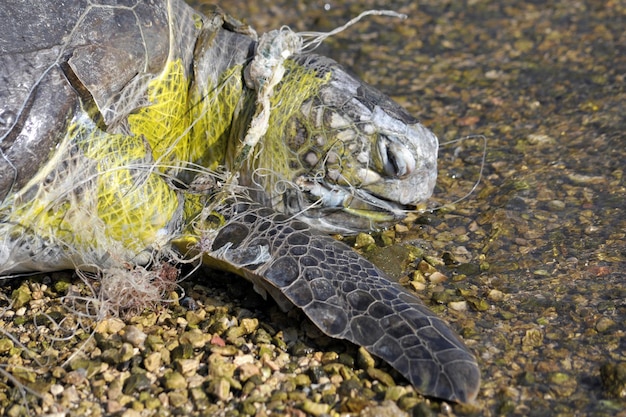
Habitat Degradation and Loss
The physical degradation and outright loss of critical marine habitats represent a severe and often irreversible threat to biodiversity in US waters. Coastal development, urbanization, dredging, and destructive fishing practices directly destroy or alter ecosystems vital for marine species survival.
Estuaries, salt marshes, mangroves, and seagrass beds serve as nurseries, feeding grounds, and protective areas for countless fish, shellfish, and bird species. These habitats also provide essential ecosystem services, such as coastal protection from storms and water filtration. When these areas are destroyed or degraded, the species dependent on them suffer direct population declines.
Dredging and Coastal Development Impacts
Dredging for navigation channels and coastal development for infrastructure like resorts and ports directly removes or smothers vital habitats. Construction activities can also increase sedimentation, clouding waters and suffocating bottom-dwelling organisms. Shoreline armoring, such as seawalls, prevents natural coastal processes and habitat migration in response to sea-level rise.
- Over 50% of US coastal wetlands have been lost, primarily due to human activity.
- Habitat fragmentation isolates marine populations, making them more vulnerable.
- Loss of natural coastal barriers increases vulnerability to storm surges and erosion.
Unsustainable fishing practices, such as bottom trawling, can cause extensive damage to seafloor habitats like cold-water corals and sponge gardens by dragging heavy gear across the bottom. This mechanical disturbance can flatten complex three-dimensional structures that provide crucial shelter and feeding opportunities for numerous species, requiring decades or even centuries for recovery.
Addressing habitat degradation necessitates comprehensive coastal zone management, stronger regulations on development and fishing practices, and significant investment in habitat restoration. Protecting existing critical habitats through marine protected areas and national marine sanctuaries is paramount. Strategies like “living shorelines” that use natural materials to stabilize coasts rather than artificial structures offer a more sustainable alternative to traditional coastal defenses.
Promoting sustainable aquaculture that minimizes habitat impacts and supporting responsible ecotourism can also contribute to habitat preservation by demonstrating the economic value of healthy ecosystems.
Overfishing and Bycatch
Despite significant advancements in fisheries management, overfishing and unintentional bycatch remain substantial threats to marine biodiversity in US waters. The removal of fish faster than populations can reproduce impacts not only target species but also the broader ecosystem.
Overfishing depletes fish stocks, reduces genetic diversity, and can lead to trophic cascades—domino effects throughout the food web. When a primary prey species is overfished, its predators may decline due to lack of food, and its own prey species may proliferate due to reduced predation pressure, disrupting ecological balance.
Challenges in Fisheries Management
Managing fisheries is complex, balancing economic interests with ecological sustainability. Despite legal frameworks like the Magnuson-Stevens Fishery Conservation and Management Act, challenges persist in data collection, enforcement, and adapting to changing stock dynamics, often compounded by climate change stressors.
- Some US fisheries are still experiencing overfishing, particularly for less commercially valuable species.
- Illegal, unreported, and unregulated (IUU) fishing undermines conservation efforts globally and can indirectly impact US waters through supply chains.
- Genetic diversity within fish populations can be reduced, making them less resilient to environmental changes.
Bycatch, the unintentional capture of non-target species, is a critical issue. This includes marine mammals, sea turtles, seabirds, and non-commercial fish species, many of which are endangered or vulnerable. Even within regulated fisheries, bycatch can amount to a significant discard of marine life, impacting populations that are not commercially exploited.
Addressing overfishing and bycatch requires robust, science-based fisheries management plans. This includes setting appropriate catch limits (total allowable catch), implementing seasonal and area closures, and using more selective fishing gear. Encouraging the adoption of technologies that reduce bycatch, such as Turtle Excluder Devices (TEDs) and seabird deterrents, is essential. Stronger enforcement against IUU fishing and promoting consumer awareness of sustainable seafood choices can also drive positive change.
Data collection and monitoring of fish stocks are vital for adaptive management. Supporting research into aquaculture practices that reduce pressure on wild fish populations also plays a role in sustainable seafood provisioning.
Invasive Species
Invasive species represent a significant and often underestimated threat to marine biodiversity in US waters. Non-native species introduced to new environments can outcompete native species for resources, introduce diseases, alter habitats, and disrupt existing food webs, leading to ecosystem imbalance and biodiversity loss.
The primary pathways for invasive species introduction include commercial shipping (ballast water and hull fouling), aquaculture escapements, and intentional releases. Once established, invasive species are often extremely difficult, if not impossible, to eradicate, making prevention the most effective strategy.
Examples and Ecological Impacts
The lionfish, for example, an invasive species in the Atlantic and Caribbean, preys on native fish and crustaceans and outcompetes them for food, with no known natural predators in the invaded range. Its rapid reproduction and voracious appetite have had devastating impacts on reef ecosystems.
- The zebra mussel, introduced to the Great Lakes, has caused significant ecological and economic damage.
- Asian shore crabs compete with native crab species and consume shellfish.
- Invasive algae can smother native seagrass beds and coral reefs.
The ecological impacts of invasive species can be profound, leading to declines in native populations, changes in community structure, and even extinctions. They can also affect ecosystem functions, such as nutrient cycling and primary productivity. For example, some invasive species can alter water quality, clarity, and substrate composition, thereby affecting a wide range of native organisms.
To address this threat, stringent regulations on ballast water management are crucial, requiring ships to exchange ballast water in the open ocean or treat it to remove organisms. Regular hull cleaning and inspections for biofouling can prevent the spread of species across regions. Early detection and rapid response protocols are vital for new incursions, though often challenging given the vastness of marine environments.
Public education about the risks of releasing non-native aquarium species or bait fish, and supporting research into control methods for established invaders, are also important components of a comprehensive strategy.
Addressing Threats: A Multi-faceted Approach
Effectively addressing the complex array of emerging threats to marine biodiversity in US waters demands a comprehensive and collaborative multi-faceted approach. No single solution will suffice; rather, a symphony of scientific, policy, technological, and community-driven actions is required.
At the heart of any successful strategy lies robust scientific research. Understanding the intricacies of marine ecosystems, the specific vulnerabilities of species, and the precise impacts of various stressors is foundational. This includes advancing oceanographic studies, ecological monitoring, and population assessments to provide the data necessary for informed decision-making. Investment in innovation, such as developing resilient species or new remediation technologies, is also critical.
Policy, Enforcement, and International Cooperation
Strong, adaptive policy frameworks are essential. This means enacting and enforcing regulations that curb pollution, protect critical habitats, and manage fisheries sustainably. Policies must be flexible enough to respond to new scientific findings and evolving environmental conditions. The establishment and effective management of Marine Protected Areas (MPAs) are key tools, offering sanctuaries where ecosystems can recover and thrive.
- Implementing stricter regulations on industrial and agricultural runoff.
- Expanding and enforcing the network of National Marine Sanctuaries.
- Funding for agencies responsible for enforcing environmental laws.
International cooperation is also paramount, as marine threats often transcend national borders. Addressing issues like global warming, transboundary pollution, and IUU fishing requires multilateral agreements and shared responsibility. The US plays a vital role in international forums to advocate for stronger global marine conservation efforts.
Finally, community engagement and public awareness are indispensable. Educating citizens about the value of marine ecosystems and the threats they face fosters a sense of stewardship. Promoting sustainable consumer choices, supporting responsible tourism, and encouraging citizen science initiatives can empower individuals to contribute to conservation. Collaboration between government agencies, NGOs, industries, and local communities ensures that solutions are both impactful and equitable.
By integrating these approaches—from cutting-edge science to grassroots actions—the US can build more resilient marine ecosystems and safeguard its invaluable biodiversity for future generations. The challenge is immense, but the potential for positive change through concerted action is equally great, making the preservation of marine life a shared endeavor.
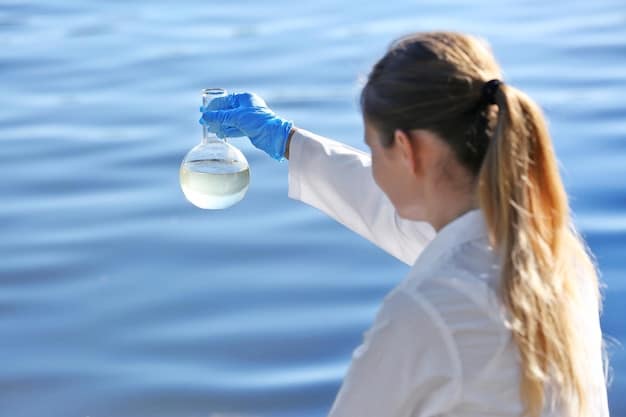
| Key Point | Brief Description |
|---|---|
| 🌡️ Climate Change | Rising temperatures and ocean acidification threaten species and habitats like coral reefs. |
| 🗑️ Pollution | Plastic and chemical contaminants harm marine life and disrupt ecosystems. |
| 🗺️ Habitat Loss | Coastal development and destructive fishing practices destroy vital marine habitats. |
| 🎣 Overfishing | Depletes fish stocks and impacts non-target species through bycatch. |
Frequently Asked Questions
Ocean acidification primarily results from the absorption of excess carbon dioxide (CO2) from the atmosphere into seawater, largely due to human activities like burning fossil fuels. This absorbed CO2 reacts with water to form carbonic acid, lowering the ocean’s pH and impacting marine organisms, especially those dependent on calcium carbonate for shells or skeletons.
Plastic pollution impacts marine biodiversity through entanglement, ingestion (mistaking plastic for food), and the leaching of toxic chemicals. Entanglement can cause injury or death, while ingestion leads to starvation or internal damage. Microplastics, specifically, can enter the food web, potentially transferring harmful substances up the chain to larger marine animals and even humans.
Marine Protected Areas (MPAs) are designated zones with restrictions on human activities to conserve marine ecosystems and biodiversity. They can serve as safe havens, allowing fish stocks to recover, protecting critical habitats, and supporting scientific research. MPAs help enhance ecosystem resilience to broader threats like climate change and offer a benchmark for understanding human impacts.
Yes, invasive species are a significant concern. Non-native species introduced through ship ballast water, hull fouling, or aquaculture escapements can outcompete native species, introduce diseases, and alter habitats. Examples like the invasive lionfish in the Atlantic demonstrate their potential to disrupt food webs and cause severe ecological damage to coastal and marine ecosystems in US waters.
Individuals can contribute by reducing their carbon footprint, minimizing plastic consumption, and properly disposing of waste. Supporting sustainable seafood choices, participating in beach cleanups, and advocating for stronger environmental policies also make a difference. Choosing eco-friendly products and being mindful of chemical runoff from homes and gardens further helps protect marine biodiversity.
Conclusion
The multifaceted threats confronting marine biodiversity in US waters demand urgent and coordinated action. From the insidious impacts of climate change and pollution to the direct pressures of habitat loss, overfishing, and invasive species, the health of our oceans reflects the aggregate of human activities. Effectively addressing these challenges necessitates a blend of rigorous scientific inquiry, robust policy enforcement, technological innovation, and, critically, a committed societal shift towards stewardship. By collaborating across sectors and empowering communities, we can forge a path toward more resilient marine ecosystems, ensuring the vibrancy and sustainability of US marine life for generations to come.
